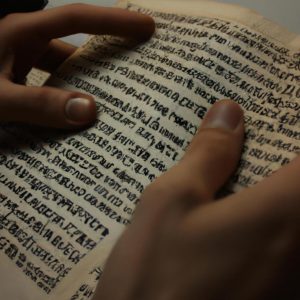Jewish Superstitions in Ashkenazi Heritage: Folklore

Jewish superstitions have been an integral part of the Ashkenazi heritage, spanning generations and serving as a window into their cultural beliefs and practices. These superstitions often revolve around folklore, encompassing various rituals, customs, and tales passed down through oral tradition. For instance, one notable example is the belief in the “evil eye,” where it is thought that certain individuals possess a malevolent gaze capable of inflicting harm upon others.
Folklore plays a crucial role in understanding Jewish superstitions within the context of Ashkenazi culture. It serves as a means to preserve collective memories and transmit moral lessons from one generation to another. The study of this rich folklore not only sheds light on historical and social aspects of Ashkenazi society but also provides insights into the fears, hopes, and aspirations deeply ingrained within these communities. By examining different superstitions like those surrounding birth, marriage, death, or everyday occurrences such as encountering black cats or breaking mirrors, we can gain a deeper understanding of how these beliefs shape their worldview and influence decision-making processes in daily life.
Overall, delving into Jewish superstitions in Ashkenazi heritage offers us valuable glimpses into the complex tapestry of their cultural identity. This article will explore various facets of Jewish superstitions within Ashkenazi heritage, highlighting their significance and impact on the community’s collective consciousness. It will delve into specific superstitions, examine their origins and cultural meanings, and discuss how they continue to shape beliefs and practices today. Additionally, it will explore the role of superstitions in fostering a sense of community cohesion and providing individuals with a framework for navigating life’s uncertainties. Through this exploration, we can gain a deeper appreciation for the rich cultural legacy that Jewish superstitions contribute to Ashkenazi heritage.
Origins of Jewish Superstitions
Imagine a young Ashkenazi boy growing up in a traditional Jewish household. Every Friday evening, before the Sabbath meal, his mother would light two candles and recite a blessing. As she did so, he observed her carefully placing a small key next to the matchbox. Intrigued by this ritualistic act, he asked his mother about its significance. She explained that it was believed to bring good luck and protection against evil spirits. This simple anecdote illustrates the rich tapestry of superstitions deeply ingrained within the Ashkenazi Jewish heritage.
The origins of these Jewish superstitions can be traced back through centuries of folklore and cultural practices. Passed down from generation to generation, they have become an integral part of Ashkenazi identity. These beliefs are often rooted in religious customs, as well as historical events and societal influences.
To better understand the complexity and diversity of Jewish superstitions within the Ashkenazi community, let us explore some common examples:
- The Evil Eye: Many Ashkenazi Jews believe in the power of the “ayin hara,” or evil eye, which is thought to cause misfortune or harm to those who attract envy or jealousy.
- Mazal Tov Charms: It is customary for newlyweds to receive gifts known as mazal tov charms, such as hamsas or red strings, symbolizing blessings and protection.
- Kapparot Ritual: Prior to Yom Kippur, some individuals perform kapparot by swinging a live chicken over their heads while reciting prayers. This practice is meant to transfer one’s sins onto the animal.
- Amulets and Talismans: Various amulets and talismans are used for different purposes in Ashkenazi culture – from warding off illness to ensuring fertility or success in business endeavors.
These examples represent just a fraction of the vast array of Jewish superstitions that have evolved over time. To further explore these beliefs, it is essential to delve into the historical and cultural contexts in which they emerged.
As we transition into the next section on “Common Jewish Superstitions,” we will examine some widely recognized traditions and their enduring significance within Ashkenazi folklore. By exploring these practices, we can gain deeper insights into the diverse tapestry of Jewish culture and its enduring connection to superstition.
Common Jewish Superstitions
Exploring the origins of Jewish superstitions provides valuable insights into the rich folklore and cultural heritage of Ashkenazi Jews. These beliefs, passed down through generations, offer a unique lens to understand how individuals navigate their lives and interpret various phenomena. To illustrate this point, let us consider the case study of Ruth, a young woman from a traditional Ashkenazi family who strongly believes in these superstitions.
Ruth’s adherence to Jewish superstitions is evident in her daily rituals and practices. For instance, she never leaves her house on Fridays without lighting Shabbat candles as it is believed to bring blessings and protection for her loved ones. Furthermore, Ruth meticulously follows the practice of placing a small piece of bread on top of every challah loaf before baking them—a gesture rooted in the belief that it will ensure an abundance of food for the household.
Understanding Jewish superstitions requires acknowledging key elements that shape these beliefs within the Ashkenazi community:
-
Cultural Significance:
- Superstitions serve as powerful markers of identity within Ashkenazi culture.
- They provide a sense of continuity with ancestral traditions and values.
- Engaging with superstitious practices fosters a connection with one’s roots.
-
Symbolism and Meaning:
- Many superstitions are deeply intertwined with religious symbolism.
- Rituals associated with these beliefs carry profound spiritual significance.
- Through adherence to these customs, individuals seek divine favor and protection.
-
Community Influence:
- The transmission of these superstitions relies heavily on communal interactions.
- Elders play a crucial role in passing down knowledge about such practices.
- Shared experiences reinforce collective belief systems among community members.
-
Emotional Resonance:
| Emotion | Example |
|---|---|
| Comfort | Feeling protected |
| Hope | Seeking blessings |
| Connection | Strengthening identity |
| Belonging | Shared practices and values |
In conclusion, Jewish superstitions in the Ashkenazi heritage hold significant cultural value and provide individuals like Ruth with a sense of connection to their community’s past. The origins of these beliefs are deeply rooted in religious symbolism and communal traditions. By understanding their emotional resonance, we gain insight into how such superstitions continue to shape personal identities within the context of contemporary Ashkenazi culture.
Superstitions Surrounding Household
Moving on from the common Jewish superstitions, let us now delve into the realm of superstitions that specifically revolve around households. To illustrate this further, consider a hypothetical scenario where a family in an Ashkenazi community believes that placing a horseshoe above their front door will bring good luck and ward off evil spirits.
The belief in household superstitions is deeply ingrained within Ashkenazi culture, often passed down from generation to generation. These beliefs are rooted in folklore and have become integral parts of daily life for many individuals. Here are some notable examples:
- Placing a mezuzah on the doorpost: A mezuzah is a small parchment inscribed with specific Hebrew verses contained inside a decorative case. Affixing it to the right side of one’s doorway is believed to invite blessings and protect against harm.
- Avoiding certain numbers: In line with broader cultural practices, Ashkenazi Jews adhere to numerological superstitions when choosing house numbers or room assignments. For instance, the number 13 may be avoided due to its association with bad luck.
- Red string protection: Some families tie red strings around their wrists or affix them to various objects throughout the home as protective talismans against negative energies or malevolent forces.
- Breaking glass at weddings: It is customary for couples during Jewish wedding ceremonies to break a glass underfoot. This act symbolizes both joy and sorrow, while also serving as a reminder of historical tragedies such as the destruction of the Temple in Jerusalem.
These examples demonstrate how rituals and symbols associated with everyday household activities can hold significant meaning within Ashkenazi communities. Now, let us move forward to explore other fascinating aspects related to birth and death superstitious beliefs among these traditions-rich cultures.
Superstitions Related to Birth and Death
In exploring the realm of Jewish superstitions within Ashkenazi heritage, it is intriguing to delve into the various beliefs and practices that surround the household. One example that sheds light on this topic involves a hypothetical case study of a traditional Jewish family residing in Eastern Europe during the early 19th century. This family firmly believed in certain superstitious practices related to their household, which were passed down through generations and deeply ingrained in their cultural identity.
To gain an understanding of the breadth of these superstitions, let us examine some common themes associated with household-related beliefs:
-
Signs and symbols:
- Placing mezuzahs (parchments inscribed with biblical verses) on doorposts as protection.
- Hanging hamsas (hand-shaped amulets symbolizing good luck) to ward off evil spirits.
- Utilizing red strings to guard against the “evil eye.”
-
Ritualistic cleaning:
- Observing meticulous cleaning rituals before Passover to eliminate chametz (leavened products).
- Sweeping away bad luck by using brooms made from specific materials or herbs.
-
Prohibitions regarding mirrors:
- Covering mirrors during times of mourning to prevent souls from getting trapped inside them.
- Avoiding looking into a mirror at night due to fears of encountering supernatural entities.
-
Charms for protection:
- Displaying small figurines, such as blue glass eyes or coins, near entrances to safeguard against malevolent forces.
Table: Household Superstitions
| Superstition | Significance | Example |
|---|---|---|
| Placing mezuzahs | Protection | Affixing parchment scrolls containing prayers |
| Hamsas | Warding off evil | Hand-shaped amulets |
| Red strings | Protecting against the “evil eye” | Tying red strings around wrists |
| Ritualistic cleaning | Purification and removal of negative energy | Thoroughly cleansing homes before Passover |
| Brooms made from specific materials or herbs | Sweeping away bad luck | Using brooms with bristles made from particular materials |
| Covering mirrors | Preventing souls from getting trapped inside | Placing cloths over mirrors during mourning periods |
| Avoiding mirror at night | Fear of encountering supernatural entities | Refraining from looking into a mirror in darkness |
These household superstitions, deeply intertwined within Ashkenazi heritage, provide a glimpse into the traditional beliefs that guided Jewish families in their daily lives. Although some may perceive these practices as irrational or outdated, they held profound emotional significance for those who practiced them.
Moving forward, we will explore additional aspects of Jewish superstitions by examining the influences surrounding birth and death in Ashkenazi culture. Through this exploration, we will gather further insights into how ancient traditions shaped the lives of individuals within this vibrant community.
Superstitions for Good Luck and Protection
Section H2: Superstitions for Good Luck and Protection
Superstitions related to good luck and protection hold a significant place in Jewish folklore, providing individuals with a sense of security and hope. These beliefs often manifest in various practices and rituals aimed at warding off evil spirits or attracting positive energy. One interesting example is the custom of hanging a hamsa, an ancient Middle Eastern symbol shaped like an open hand, near doorways or wearing it as jewelry. It is believed that the hamsa offers protection against the “evil eye,” a malevolent glare cast by others.
- Wearing red strings: Many Jews wear red strings around their wrists as a means to ward off negative energies or ill fortune.
- Mezuzah on doorposts: Placing mezuzahs (small parchment scrolls containing verses from Deuteronomy) on doorposts is considered auspicious and serves as a symbolic shield against harm.
- Mazal Tov charms: Amulets such as horseshoes, blue eyes, or stars of David are carried or displayed to attract good fortune.
- Protective blessings: Recitation of specific prayers or blessings before undertaking important activities, such as traveling or starting new endeavors, is thought to invoke divine safeguarding.
The significance of these customs can be better understood through examining their historical context. The table below provides examples of common symbols used in Jewish superstitions for good luck and protection:
| Symbol | Meaning |
|---|---|
| Hamsa | Hand-shaped talisman for defense |
| Red string | Warding off negativity |
| Mezuzah | Divine protection |
| Mazal Tov charm | Attracting good fortune |
These customs demonstrate not only how deeply ingrained superstitions are in Ashkenazi heritage but also how they continue to shape the lives of individuals today. By adhering to these beliefs and practices, people find solace in knowing that they have taken precautionary measures against potential harm or misfortune.
As Jewish folklore evolves over time, it is intriguing to examine the origins and transformations of these superstitious customs. In the following section, we will delve into the evolution of Jewish superstitions and their enduring presence in contemporary society.
Evolution of Jewish Superstitions
Section H2: Evolution of Jewish Superstitions
From the superstitious beliefs rooted in Ashkenazi heritage, we now turn our attention to the evolution and transformation of these practices over time. This section will explore how Jewish superstitions have adapted and thrived within a changing world, reflecting both cultural continuity and shifts in belief systems.
One fascinating example that illustrates this evolution is the superstition surrounding the “evil eye.” Traditionally, it was believed that certain individuals possessed the power to cast curses or bring misfortune upon others through their envious gazes. In recent years, however, this concept has taken on new forms as people incorporate technology into their lives. With the rise of social media platforms like Instagram and Facebook, some individuals fear that by displaying their success or happiness online, they may attract negative energy from those who are less fortunate. This modern interpretation demonstrates how Jewish superstitions adapt to contemporary contexts while still addressing age-old concerns about envy and its potential consequences.
As Jewish communities have dispersed across different geographic regions throughout history, local customs have influenced the development of specific superstitions. To better understand this phenomenon, let us examine four key factors that contribute to the diversification of Jewish superstitious practices:
- Geographical location: The unique characteristics of each region shape local folklore and traditions. For instance, Jews living in Eastern Europe developed distinct superstitions related to nature spirits and mystical creatures such as golems.
- Interactions with other cultures: As Jews migrated and interacted with diverse populations, they assimilated certain elements from other religious or folkloric traditions. These cross-cultural exchanges often result in hybridized versions of existing superstitions.
- Historical events: Significant historical events can leave lasting imprints on collective memory and influence prevalent superstitions among affected communities. For example, experiences during times of persecution may give birth to protective rituals associated with warding off evil forces.
- Socioeconomic background: Social conditions and economic challenges faced by various Jewish communities can also contribute to the formation of specific superstitions. Poverty, for instance, may lead to beliefs in magical objects or rituals that promise wealth or prosperity.
To further illustrate the diversity of Jewish superstitions across different regions and time periods, let us consider a comparative analysis using a three-column table:
| Region | Time Period | Notable Superstition |
|---|---|---|
| Eastern Europe | 19th century | Placing garlic near doorways to ward off evil spirits |
| Middle East | Medieval period | Wearing amulets with Hebrew inscriptions for protection |
| North America | Present day | Breaking a glass at weddings to bring good luck |
This table showcases how Jewish superstitious practices have evolved over time while maintaining their underlying themes of protection, luck, and warding off negative energies. The examples presented demonstrate the dynamic nature of these beliefs as they respond to historical shifts and cultural influences.
In summary, this section has explored the evolution of Jewish superstitions within Ashkenazi heritage. We have seen how traditional beliefs adapt to modern contexts such as social media platforms and examined key factors that shape regional variations in superstitious practices. By understanding the development and transformation of these traditions, we gain insight into the rich tapestry of Jewish folklore and its continued relevance today.



